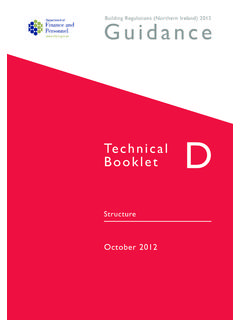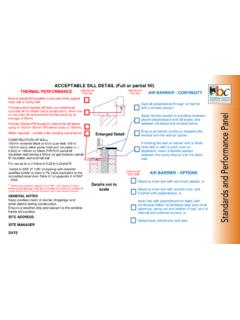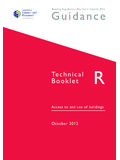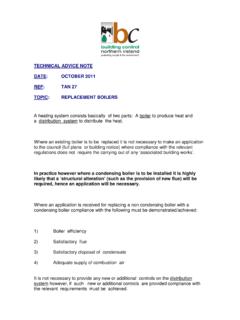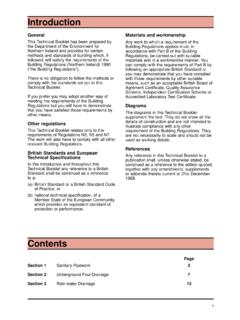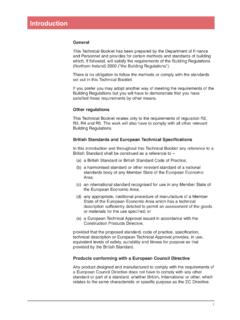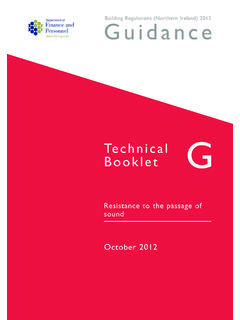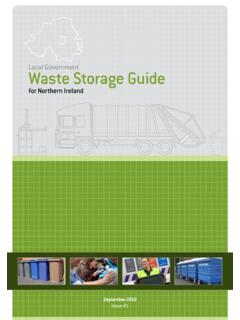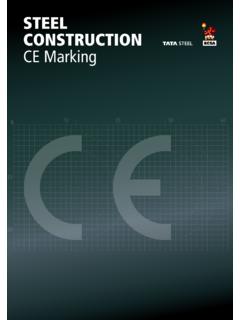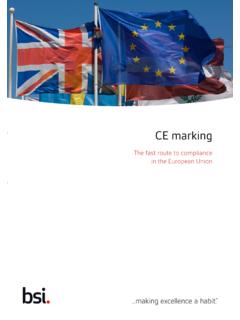Transcription of Technical Booklet H 2006 - Building Control NI
1 GeneralThis Technical Booklet has been prepared by the Department of Financeand Personnel and provides for certain methods and standards of buildingwhich, if followed, will satisfy the requirements of the Building Regulations(Northern Ireland) 2000 ("the Building Regulations").There is no obligation to follow the methods or comply with the standardsset out in this Technical you prefer you may adopt another way of meeting the requirements of theBuilding Regulations but you will have to demonstrate that you havesatisfied those requirements by other regulationsThis Technical Booklet relates only to the requirements of regulation H3,H4, H5, H6 and H7. The work will also have to comply with all otherrelevant Building Standards and European Technical SpecificationsIn this introduction and throughout this Technical Booklet any reference to aBritish Standard shall be construed as a reference to (a) a British Standard or British Standard Code of Practice;(b) a harmonised standard or other relevant standard of a nationalstandards body of any Member State of the European EconomicArea;(c) an international standard recognised for use in any Member State ofthe European Economic Area;(d) any appropriate, traditional procedure of manufacture of a MemberState of the European Economic Area which has a technicaldescription sufficiently detailed to permit an assessment of the goodsor materials for the use specified.
2 Or(e) a European Technical Approval issued in accordance with theConstruction Products Directive,provided that the proposed standard, code of practice, specification, Technical description or European Technical Approval provides, in use,equivalent levels of safety, suitability and fitness for purpose as thatprovided by the British conforming with a European Council DirectiveAny product designed and manufactured to comply with the requirements ofa European Council Directive does not have to comply with any otherstandard or part of a standard, whether British, International or other, whichrelates to the same characteristic or specific purpose as the EC marked construction productsAny construction product (within the meaning of the construction ProductsDirective) which bears a ce marking shall be treated as if it satisfied therequirements of any appropriate British Board of Agr ment Certificate,British Standard or British Standard Code of Practice relating to such aproduct, where the ce marking relates to the same characteristic or specificpurpose as the Certificate, Standard or Code of Practice.
3 Testing of materials and constructionWhere for the purposes of this Technical Booklet testing is carried out itshall be carried out by an appropriate organisation offering suitable andsatisfactory evidence of Technical and professional competence andindependence. This condition shall be satisfied where the testingorganisation is accredited in a Member State of the European EconomicArea in accordance with the relevant parts of the EN 45000 series ofstandards for the tests carried and workmanshipAny work to which a requirement of the Building Regulations applies must,in accordance with Part B of the Building Regulations, be carried out withsuitable materials and in a workmanlike manner. You can comply with therequirements of Part B by following an appropriate British Standard or youmay demonstrate that you have complied with those requirements by othersuitable means, such as an acceptable British Board of Agr mentCertificate, Quality Assurance Scheme, Independent Certification Schemeor Accredited Laboratory Test diagrams in this Technical Booklet supplement the text.
4 They do notshow all the details of construction and are not intended to illustratecompliance with any other requirement of the Building Regulations. Theyare not necessarily to scale and should not be used as working references in this Technical Booklet to a publication shall, unlessotherwise stated, be construed as a reference to the edition quoted,together with any amendments, supplements or addenda thereto current at30 June 2006 .2pageIntroduction1 Section 1 General4 Section 2 Stairs6 Section 3 Ramps16 Section 4 Guarding21 Section 5 Vehicle loading bays24 Section 6 Protection against impact from and trapping by doors25 Section 7 Protection from collision with open windows,skylights or ventilators27 AppendixPublications referred to283 Contents Part H does not require a Building , other than a dwelling of more than onestorey, to have a stair. However, where a stair or ramp is provided it mustcomply with the requirements of Part stair or ramp which forms part of a means of escape in the case of fire asrequired by Part E, may need to meet requirements in that part which areadditional to the provisions described in this a dwelling or a block of dwellings, a stair or a ramp which forms part of ameans of access as required by Part R, may need to meet requirements inthat part which are additional to the provisions described in this open window, skylight or ventilator that projects into the space over ameans of access as required by Part R, may need to meet requirements inthat part which are additional to the provisions described in this In this Technical Booklet the following definitions apply Going(in relation to a step) the depth of the tread less any overlap withthe next tread (see Diagram ).
5 Private stair a stair in or intended to be used by only one Building shop, department store, supermarket, public house,restaurant with or without assembly area, cafe, hairdresser, wholesale self-selection trading, public area of a bank, Building society, betting (in relation to a step) the height, including the thickness of the tread(see Diagram ).Small room any room in a dwelling having a floor area not in a dwelling, does not include any threshold which has a height notexceeding 40 mm in the case of an internal doorway or 75 mm in the caseof an external width the width of a stair or ramp, measured at the tread of astep or the surface of a ramp, between any enclosing walls, strings,upstands, kerbs or tread a tread which has a greater width at one side than at theother and a going which changes at a constant rate throughout its 1 GeneralVisual contrast contrast is the perception of a difference visually between oneelement of a Building and another by reference to their light reflectance value (LRV) is the total quantity of visible light reflected bya surface at all wavelengths and directions when illuminated by a people with adequate vision, differences in the nature or the intensity ofcolour provide adequate visual contrast.
6 Unfortunately, this is not the casefor all people who are visually impaired. The main feature of a surface,which appears to be strongly correlated with the ability of visually impairedpeople to identify differences in colour, is the LRV. Differences in LRV canbe used to assess the degree of visual contrast between the surfaces ofelements such as handrails, step nosings LRV scale runs from 0, which is a perfectly absorbing surface thatcould be assumed to be totally black, up to 100, which is a perfectlyreflective surface that could be considered to be the perfect of practical influences in any application, black is always greaterthan 0 and white never equals difference in LRV of 30 points or more allows a degree of variability thatis required to provide reasonable visual risernosingopen riser treads shalloverlap atleast 16 mmrisertop surface of treadtop surface of treadrisegoing dimensionto be measuredfrom nosing to nosinggoingclosed risersee paras , and Measuring rise and going5 Common provisions for all private stair or a common stair in a block of dwellings, shall comply withthe provisions of paragraphs to stair in a Building other than a dwelling or a common stair in a block ofdwellings.
7 Shall comply with the provisions of paragraphs to to The pitch of a flight shall be controlled by limiting the rise and the shows how the pitch shall be measured and what is meant bythe pitch line. Diagram shows how to measure the rise and Subject to paragraph the relationship between the dimensions of therise and going is that twice the rise (R) plus the going (G) (2R + G) shallbe between 550 mm and 700 mm. The rise and the going are given inTable Rise and goingCategoryRiseGoingminimum(mm)maximum (mm)minimum(mm)1 Private stair752202202A common stair in a block ofdwellings751702503A stair in any Building (otherthan a private stair or acommon stair in a block ofdwellings)150170250 Note A stair within more than one category shall be constructed to the more onerousstandardsee para line - a notional line connecting the nosings of all treads in a flight angle ofpitchhorizonalpitch lineDiagram Measuring angle of pitch6 Section In a flight, the steps shall all have the same rise and they shall all have thesame going.
8 Where the landing of a stair is formed by the ground and slopes across thewidth of the flight, then the rise of the step shall be measured at the mid-point of the width of the flight (see paragraph ). Steps shall have level treads which extend for the full width of the A stair shall have a clear headroom of not less than 2000 mm over its fulllength and is measured vertically from the pitch line of the flight and thelevel of the landing (see Diagram ).Change of A stair of more than 36 rises in consecutive flights shall have at least onechange in direction between flights of at least 30 (see Diagram ).not less thanthe stair widthangle atleast 30ostairwidthflightflightlandingsee para Change of directionnot lessthan 2000 mmnot lessthan 2000 mmnot lessthan 2000 mmpitch lineminimumheadroomsee para Measuring Landings shall be level unless they are formed by the ground at the top orbottom of a flight where they may have a gradient not greater than (a) 1 in 20 in the case of a private stair.
9 Or(b) 1 in 60 for all other formed by the ground shall be paved or otherwise made provisions for private stairs and common stairs inblocks of pitch of a private stair shall not exceed 42 , therefore it is not possibleto combine a maximum rise with a minimum rise and the going are given in Table of The minimum unobstructed widths for a flight, in a private stair and acommon stair in a block of dwellings, are given in Table and shall bemeasured in accordance with Diagram Widths of flights in a private stair and a common stair ina block of dwellingsCategoryMinimum unobstructedwidth (mm)1 Private stair -(a) providing access to one room only (not being a kitchen or living room) or to a bathroom and a water closet (b) other than (a) above 6008002A common stair in a block of dwellings10008 construction of A private stair may have steps with open rises, but the treads shall thenoverlap each other by at least 16 mm (see Diagram ).A private stair which has open rises, shall be constructed so that a 100 mmdiameter sphere cannot pass through the open common stair in a block of dwellings shall have steps with rises that arenot open and have a suitable profile such that the risk of tripping is reduced(see Diagram (b)).
10 The number of rises in a flight shall be a maximum of 16 and a minimumof 2. However, notwithstanding the provisions of paragraph , a singlestep may be provided (a) at the bottom of a stair in a dwelling;(b) at an entrance to a dwelling;(c) between any enclosed porch, outhouse or conservatory and theremainder of a dwelling;(d) where it provides access to a small room; and(e) between a garage and a A landing shall be provided at the top and bottom of every width of a landing shall be not less than the width of the going of a landing shall be not less than the width of the of a floor may be considered as a landing. see para widths see Table intrusions suchas string/skirting and newel may be ignoredDiagram Measuring the width of a private stair and a common stair in a block of A landing shall be clear of any obstruction. However, in a private stair (a) a door may swing across a landing at the bottom of a flight but onlywhere it will leave a clear space of at least 400 mm across the fullwidth of the flight (see Diagram ); and(b) a door to a cupboard or duct may swing across a landing at (i) the bottom of a flight; and(ii) the top of a flight where it will leave a clear space of 400 mmacross the full width of the flight (see Diagram ).
